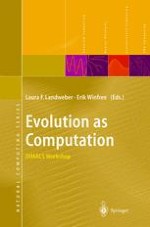2002 | OriginalPaper | Buchkapitel
The Impact of Message Mutation on the Fitness of a Genetic Code
verfasst von : Guy Sella, David H. Ardell
Erschienen in: Evolution as Computation
Verlag: Springer Berlin Heidelberg
Enthalten in: Professional Book Archive
Aktivieren Sie unsere intelligente Suche, um passende Fachinhalte oder Patente zu finden.
Wählen Sie Textabschnitte aus um mit Künstlicher Intelligenz passenden Patente zu finden. powered by
Markieren Sie Textabschnitte, um KI-gestützt weitere passende Inhalte zu finden. powered by
The standard genetic code (SGC) is organized in such a way that similar codons encode similar amino acids. One of the earliest explanations for this was that the SGC is the result of natural selection to reduce the fitness cost, or “load,” from mutations in and mistranslation of protein-coding genes. However, it was later argued on both empirical and conceptual grounds that the SGC could not have evolved to reduce load. We claim that the empirical evidence has been misinterpreted and review how the pattern of amino acid similarities in the SGC are consistent with the “load minimization hypothesis” or “LM hypothesis.” We then present a model which addresses a second classical objection to the load minimization hypothesis: that selection for load minimization must be indirect or weak because it acts across generations. In this model, individual fitness is determined by a protein distribution resulting from the translation of its genetic message using a genetic code. Amino acids contribute independently and multiplicatively to the fitness of the protein distribution, which is defined relative to a fixed target protein. We show that in mutation-selection balance a fitness can be associated with a population of individuals with the same genetic code, and illustrate that structure-preserving codes that assign similar codons to similar amino acids confer higher fitness. We also show that in mutation-selection balance the total message of any individual behaves like a population of sites. That is, the usage of codons in a message in almost any individual reflects the codon frequencies across the population for a site of a given type, and consequently the fitness of almost all individuals is equal to the population fitness associated with their genetic code. We thereby establish that selection for load minimization in genetic codes acts at the level of an individual in a single generation. Comparing the fitness of two genetic codes, one more structure-preserving than the other, we find that the more structure-preserving code is associated with lower load and consequently higher fitness, despite the fact that the equilibrium fraction of mutant codons in its mutation-selection balance is larger; these results are explained and conjectured to hold in general. We conclude with comments on the origin of the genetic code from the perspective of a model of this kind, including its shortcomings and advantages over other hypotheses as a comprehensive explanation for the origin of the SGC.
